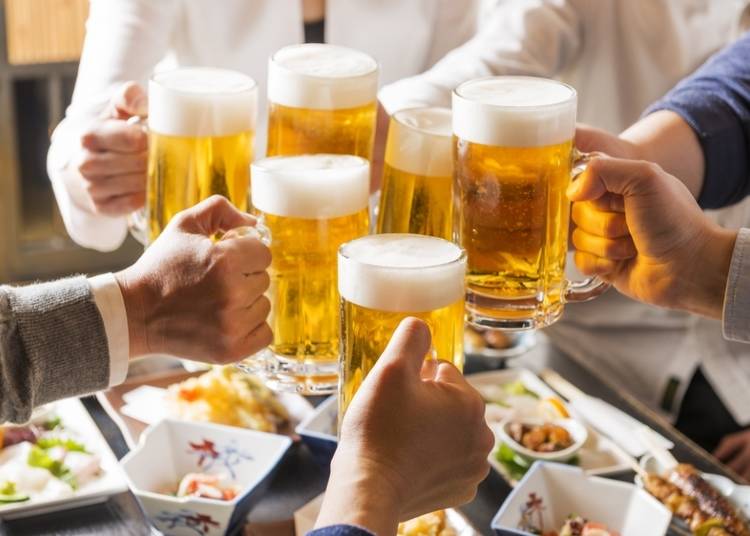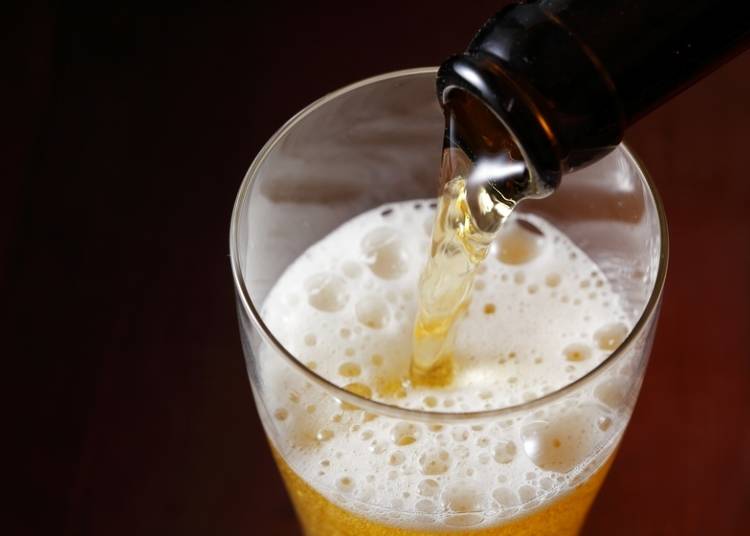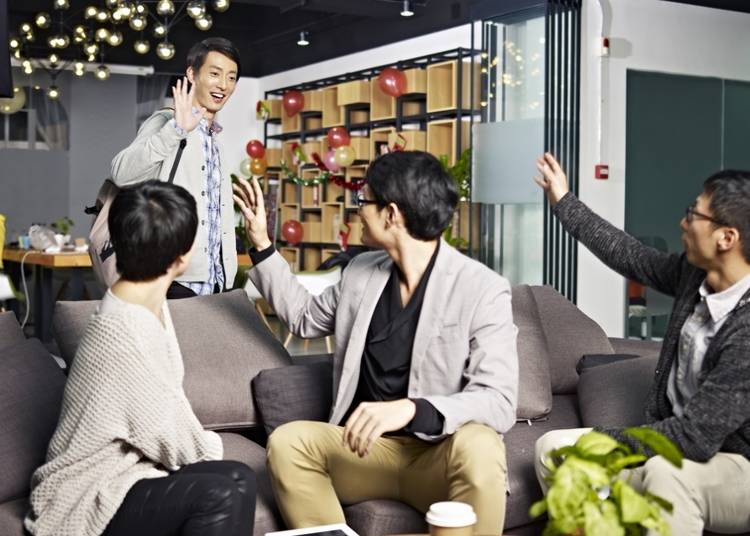
It’s not easy being new in Japan. The first issue is that until you get up to speed on the language, you really can’t do anything useful. You can’t read signs, you can’t understand anyone or anything, and it seems like everyone is rushing all around you to get from one place to the next. It can be like standing in the eye of a cultural hurricane.
Once you are finally able to speak for yourself, you may still feel as if you’re just not fitting in. This is due to the variety of unspoken Japanese rules and customs that can be confusing for newcomers. But once you learn them, they can be a wonderful cultural souvenir to take back home with you.
So, if you want to win friends and fit in, read on for tips on handling one of the most common Japanese social events--how to act when you’re invited to a drinking party!
Japanese Drinking Etiquette Tip #1: Before the Toast

Do not arrive late. Being late can be a source of concern to your Japanese host and can be considered rude. Arriving late can be a hassle for everyone because they might think that you are lost and can’t find your way. The best way to avoid giving your host grief is to show up around ten minutes early.
An invitation to drink in Japan can arrive in many of different contexts. It’s part of the Japanese business cultural experience that colleagues and their superiors share after work drinks, but can just as easily be a casual gathering of friends. Whatever the circumstances, there are important rules to observe if you don’t want to seem rude or ignorant.
First, it is important to know who your superiors are and who are the seniors in the room. When you come in, you should acknowledge the people in the room and quietly greet them, so as to not attract attention.
If you don’t know someone’s name, ask and try to remember them. In Japanese, anata (the Japanese version of “you”) is considered too personal. You should call people with whom you are not familiar by their first or last name followed by -san. This establishes a respectful atmosphere, which can later bloom into a new friendship.
After the introductions, take your seat. The seat closest to the entrance is called shimoza (lower seat), so the politest thing to do under any circumstance is to sit there or someplace close to it. Whatever you do, don’t sit at the back of the room away from the entrance! This one is the kamiza; a seat for higher-ranking members.
Japanese Drinking Etiquette Tip #2: Kanpai!

Every language has its own translation: “cheers” in English, “santé” in French, “gān bēi” in Chinese, and each culture attaches its own importance to it. Know that it is very important in Japan that you do not approach the drinks by yourself at the beginning. Instead, wait for someone to give you a glass.
The first drink is poured for everyone at the same time. Before you start sipping, wait for the magic word: “Kanpai!” When you clink the glasses, yours should be at a lower angle than your superior’s or elder’s. Respecting those rules creates a moment of friendship and bonding, which is the first step in making new friendships.
Japanese Drinking Etiquette Tip #3: Stay Alert!

Don’t let the Japanese alcohol take over! After the first drink, remember to stay attentive and watch the glasses of others around you. When their glasses are empty, ask what they want to drink and pour it for them. If your glass is empty, wait for somebody to ask if you want a refill, as serving yourself will seem too casual in front of your senior and superior.
To pour a drink for someone else, use both hands to hold the bottle. Make sure the bottle’s label is facing up, and that your left hand is supporting it at the center. The glass should be held at a slight angle by the person receiving the drink to facilitate the refill. It's also considered a humble gesture to initially pretend to refuse the drink. The person pouring always insists, as it is considered to be a key part of hospitality.
Also, be sure to converse with your fellow partygoers. Don’t worry if your Japanese language skills are poor! Drinking parties are all about getting to know one another, and you may find yourself talking about where you are from, why you came to Japan, and about many other interesting topics. People will help you with your Japanese, or may even want to practice their English.
Japanese Drinking Etiquette Tip #4: When You Leave

Departures sometimes create awkward moments. The best method is to wait for the host or a superior to decide when the party's over. If you leave before the rest of the party, then you’ll stand out and the host will wonder why you left so early.
Also, what about the bill? No one likes the person who leaves someone else with the bill, no matter what culture everyone is from. If you know you must leave early, be sure to let the host know and make arrangements concerning the payment in advance.

When the party is over, kindly offer your help cleaning up and thank everyone for the night. Be sure to collect your belongings! It is better to not forget anything so you don’t have to return and perhaps create a new awkward situation.
This may all seem very complicated, and there are many subtleties to observe. Don’t worry! As a rule, the Japanese are very nice people. If they see you trying to respect their customs, they will understand that you can’t do everything perfectly (they may even forget themselves, if they have a bit too much to drink). So relax, enjoy the cultural experience, and make some new friends!
*Prices and options mentioned are subject to change.
*Unless stated otherwise, all prices include tax.
Popular Tours & Activitiess
Recommended places for you
-
Goods

Yoshida Gennojo-Roho Kyoto Buddhist Altars
Gift Shops
Nijo Castle, Kyoto Imperial Palace
-

Kambei Sannomiyahonten
Yakiniku
Kobe, Sannomiya, Kitano
-

Kanzenkoshitsuyakinikutabehodai Gyugyu Paradise Sannomiya
Yakiniku
Kobe, Sannomiya, Kitano
-

ISHIDAYA Hanare
Yakiniku
Kobe, Sannomiya, Kitano
-

Jukuseiniku-to Namamottsuarera Nikubaru Italian Nikutaria Sannomiya
Izakaya
Kobe, Sannomiya, Kitano
-
Appealing

Rukku and Uohei
Izakaya
Sapporo / Chitose
-

Enjoy Japan's Gorgeous Winter Lights! Ride the Romancecar to Shonan no Hoseki Illumination
by: Guest Contributor
-

Don't Miss Out! The One Thing You Must Do Before Shopping at Mitsui Shopping Park LaLaport: Get Your Max 10% OFF Coupon Book
-

A Travel Game Changer! Go Hands-Free Between Tokyo and Kyoto with LUGGAGE EXPRESS by JTB and JR Tokai
by: Guest Contributor
-

LaLaport TOKYO-BAY North Building Now Open: Shop, Dine & Enjoy Events at LaLa arena, Just 2 Stops from Disney
by: Wemmy Chau
-

2025 Autumn Colors Report: Kurobe Gorge Nearing Peak
by: Timothy Sullivan
-

Black Friday 2025: These Are THE Japan Travel & Shopping Deals to Check Out
-

Okonomiyaki: Try Japan’s Favorite Soul Food at an Authentic Teppanyaki Restaurant
-
Ad

Visiting Kyoto on a Weekend or Holiday? Smoothly Visit Kyoto’s Kiyomizu-dera & Ginkaku-ji Temples on the New Sightseeing Limited Express Bus
-

Autumn in Japan 2025: Fall Foliage Forecast & Where to Enjoy the Colorful Leaves (+Tour Info)
-

Todai-ji Temple: Home to the Great Buddha of Nara - And a Nose Hole That Brings You Luck!?
by: WESTPLAN
-

ATMs in Japan: About Using International Cash and Credit Cards
-

Spa LaQua: Experiencing a Natural Hot Spring in the Middle of Tokyo
- #best sushi japan
- #what to do in odaiba
- #what to bring to japan
- #new years in tokyo
- #best ramen japan
- #what to buy in ameyoko
- #japanese nail trends
- #things to do japan
- #onsen tattoo friendly tokyo
- #daiso
- #best coffee japan
- #best japanese soft drinks
- #best yakiniku japan
- #japanese fashion culture
- #japanese convenience store snacks












